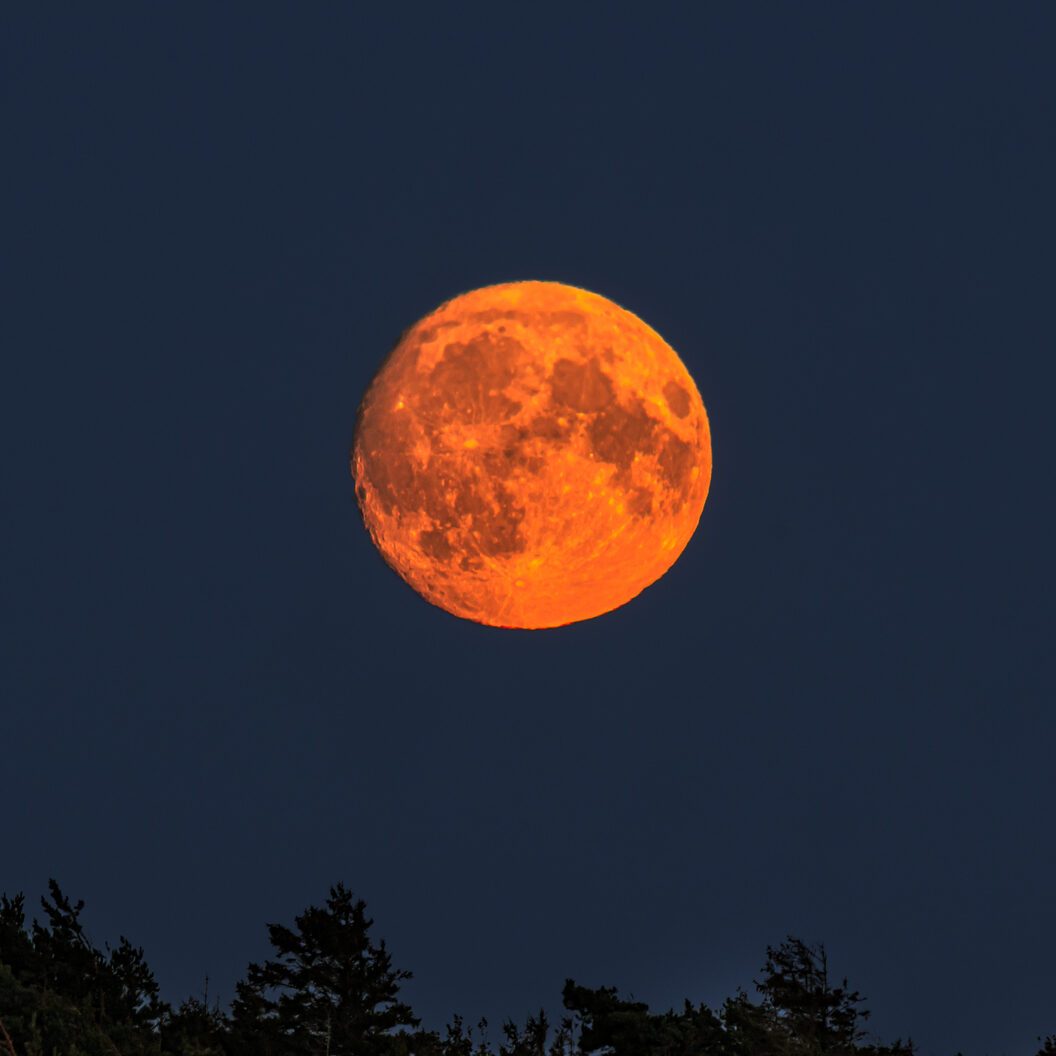Seriously, what is going on?

Here’s Why the Moon Turns Red—And When It Will Happen Next

We tend to take the moon for granted—after all, it’s there night after night, just hanging out in the starry sky. But occasionally, it does something particularly cool or looks even more amazing than normal in its crescent or full states. And then sometimes it just goes completely off the rails, like when it turns a disturbing shade of red. It seems like a biblical omen or an atmospheric meltdown, but we promise you that there’s a (not-so-terrifying) scientific reason for this so-called blood moon. But what is a blood moon, exactly, and why does the moon turn red?
We consulted two astronomy experts to get the lowdown on this lunar phenomenon. Read on to find out all the details and interesting facts about the blood moon—and how to catch a glimpse of this rare event.
Get Reader’s Digest’s Read Up newsletter for more interesting facts, humor, cleaning, travel and tech all week long.
When does the moon turn red?
The moon turns red only during a total lunar eclipse, when the sun, Earth and moon align in a nearly straight line and the moon is fully in Earth’s shadow. The resulting red-hued moon—which is visible only in this shadow state—is called a blood moon.
Blood moons are relatively rare. While, on average, there are between one and three total lunar eclipses (and blood moons) a year, some years there are none. The last total lunar eclipse that was visible in the U.S. was in March 2025, and before that, it was back in 2022.
Why does the moon turn red?

“Having color in Earth’s shadow is odd because you would think the Earth completely blocks light, and it does—the culprit is our atmosphere,” says Jillian Bornak, PhD, distinguished lecturer in physics and astronomy at the University of Toledo.
Settle in for a little (easy-to-understand) science lesson. The first thing you need to know is something you learned in high school: Air can refract, or bend, light. In the case of a total lunar eclipse, Bornak explains, “some of the light coming straight across the atmosphere at sunset and sunrise gets bent and redirected into Earth’s shadow.” (The darkest part of Earth’s shadow, by the way, where the moon is located during the eclipse, is called the umbra.)
The next important bit of info is that the sun’s rays are made of differently colored light waves. Blue light waves, which are shorter and smaller, scatter when they hit the Earth, but red light waves can reach longer distances. “Only the deepest reds and orange light can make it through to the shadow without getting scattered,” Bornak says. “You could say Earth’s shadow always has a tiny piece of the sunrises and sunsets happening simultaneously around the planet.” When this red light hits the moon in the umbra, the moon appears red. And voila—that’s the reason for your blood moon!
How red does the blood moon get?
The color during a total lunar eclipse is more of a deep orange than blood red. But interestingly, the exact shade varies with each full lunar eclipse since there are slight differences in Earth’s atmosphere each time.
“This variation in color means scientists get to learn about Earth’s atmosphere as a snapshot during each total eclipse,” Bornak says. Factors in the sky like pollution, clouds, dust or particles from volcanic eruptions can alter the shade, explains Brian Lada, a meteorologist and astronomy expert at AccuWeather.
When is the next blood moon?
The next blood moon will occur on Sept. 7, 2025, but it will be visible only in Asia, Australia and parts of Europe and Africa. The next blood moon that will be visible in the United States, however, will be on Tuesday, March 3, 2026. After that, you’ll have to wait another three years to catch a glimpse of the next one on June 26, 2029!
One important note: The total lunar eclipse in March 2025 lasted for more than an hour, so people were more likely to be able to catch it, says Lada. But sometimes it lasts for mere minutes. Translation: Set your alarm for the exact time of the maximum eclipse, and get yourself outside pronto!
How can you see a blood moon?
According to NASA, you don’t need any special equipment to see a blood moon. The one thing that could complicate matters? Clouds.
“During [2024’s] total solar eclipse,” Lada says, “cloud cover was critical since the main event only lasted a few brief moments.” The March 2025 total lunar eclipse lasted for 65 minutes, so even though it wasn’t a perfectly clear night in some areas, you just needed to wait for breaks in the clouds to pass near the moon to catch it.
Of course, if the weather doesn’t cooperate, Lada says, “you’ll have to resort to watching the eclipse online.”
What is a worm moon—and is it true that the March 2025 eclipse was also one of those?
Worm moon is just a name for a full moon that rises in March, according to Lada. “This is connected to springtime weather,” he explains. “As temperatures rise and soil softens, worms begin to reappear, especially following springtime rains.” So on March 13 and 14, 2025, we got a blood moon and worm moon in one! Just not a supermoon—hey, you can’t have everything!
Will there be a solar eclipse anytime soon?
According to NASA, eclipses always arrive in pairs, with a partial solar eclipse happening a few weeks before or after a lunar eclipse. Who knew?!
About the experts
|
Why trust us
At Reader’s Digest, we’re committed to producing high-quality content by writers with expertise and experience in their field in consultation with relevant, qualified experts. We rely on reputable primary sources, including government and professional organizations and academic institutions as well as our writers’ personal experiences where appropriate. For this piece on why the moon turns red, Lisa Lombardi tapped her experience as a longtime health and science reporter. We verify all facts and data, back them with credible sourcing and revisit them over time to ensure they remain accurate and up to date. Read more about our team, our contributors and our editorial policies.
Sources:
- Jillian Bornak, PhD, physics and astronomy professor at the University of Toledo; email interview, March 10, 2025
- Brian Lada, meteorologist at AccuWeather; email interview, March 12, 2025
- NASA: “Future Eclipses”
- NASA: “What You Need to Know About the March 2025 Total Lunar Eclipse”
- NASA: “What’s Up: March 2025 Skywatching Tips from NASA”
- Space.com: “What is a blood moon?”























